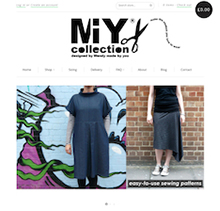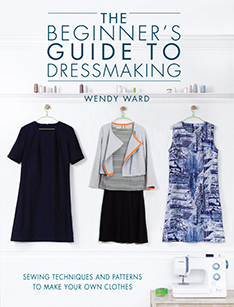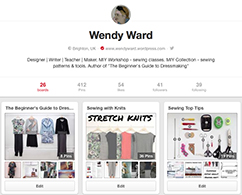For the last 2 months I’ve been talking about how to use and organise your leftover scrap fabrics and your fabric stash. So now you have a beautifully edited and organised stash of fabric, but no doubt you also have a pattern stash?! Here are my tips for how to streamline and organise your pattern collection and a quick guide for teaming fabrics with patterns.
Go through your wardrobe and pull out the garments you most enjoy wearing. You could even take photos of them and create a moodboard or a “My Style” Pinterest board (this is probably a good version of that for me). Hopefully a pattern will start to emerge of styles, shapes and details.
You might also begin to see some gaps that could be filled with particular garments.
Next get an accurate set of your body measurements; include your cup size as well as your bust, inside leg and your preferred skirt lengths. Always refer to these measurements when choosing your pattern size, DO NOT go by dress sizes on patterns – they’re meaningless (read why here), get to know your body measurements and just go by the size chart and finished garment measurements on the pattern.
Download a copy of my guide to taking measurements:
Next, go through your patterns and using the flat technical drawings so as not to be distracted by photographs and illustrations, pull out all the ones that you would wear and that fit in with the styles you identified in step 1. Be honest with yourself!
Once you have made a pile of “possibles” go through these patterns again and check that the sizes covered by each pattern include your measurements (remember to check both the body measurement chart AND the finished garment measurements of the pattern). Put all those that cover your measurements to one side, the rest are your reject patterns to get rid of.
Like with your culled fabrics, there are lots of ways to get these patterns out of your life:
- sell them online – there’s always Ebay, but social media sites like Instagram are becoming popular in the sewing community for regular “Destash Sales”,
- organise a pattern swap with your crafty friends at a class or meet-up,
- donate them to your local charity shop or school.
What’s the best way to store your newly edited library of patterns? Patterns come in a wide range of shapes and sizes and then there are PDF patterns.
As with fabrics, I’m a fan of the clear plastic stackable box approach, but here are some more ideas for storing your patterns:
- paper patterns that you think you’re likely to use several times need to be more durable – transfer the pieces onto card or iron interfacing onto the backs of the pattern sheets before cutting out the pieces,
- store card and interfaced patterns on pattern hooks and hang them along with any toiles you’ve made of the patterns,
- don’t try to stuff cut out paper patterns back into their envelopes, either store the pieces in a card or plastic folder and keep them on a shelf or put the pieces in a clear plastic sleeve and put the sleeve on a hanger along with any toiles you’ve made of the pattern,
- don’t roll patterns that are on card or stiffer paper – they will never lie flat again and will drive you bananas!
It’s time to shop your fabric stash! Take each of your edited patterns and see if you can find a suitable fabric in your (now beautifully organised) fabric stash.
Each pattern will have a list of suggested fabrics, if you’re still quite new to sewing, these lists can be quite confusing.
To help you out I’ve put together 2 checklists:
- a fabric checklist which explains by fabric name some of the more common fabrics, along with what kind of styles they best suit and their typical fibre content,
- a project checklist for you to better plan your sewing projects.
You can download them here.
If you’re planning to make a pattern that you haven’t made before, make a quick toile in a similar weight, substitute fabric first to check whether you want to make any tweaks to the fit or style.
Once you’ve sewn with a range of different fabrics and have an idea of how they behave, what they’re like to sew and how much you enjoy wearing them, you can experiment with substituting the fabrics recommended for your patterns.
























Pingback: Shop Your Stash – Planning Your Makes | Wendy Ward
I definitely need to cull my pattern stash. It is way larger than my fabric stash!
LikeLike
We’re all guilty of it aren’t we?! Good to clear it out so you can get to the good stuff though.
LikeLiked by 1 person